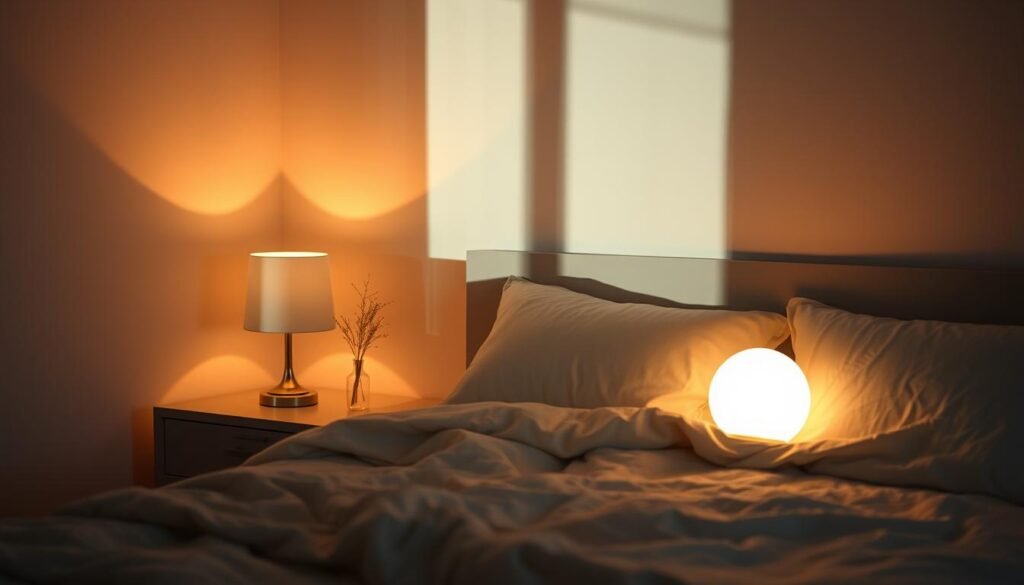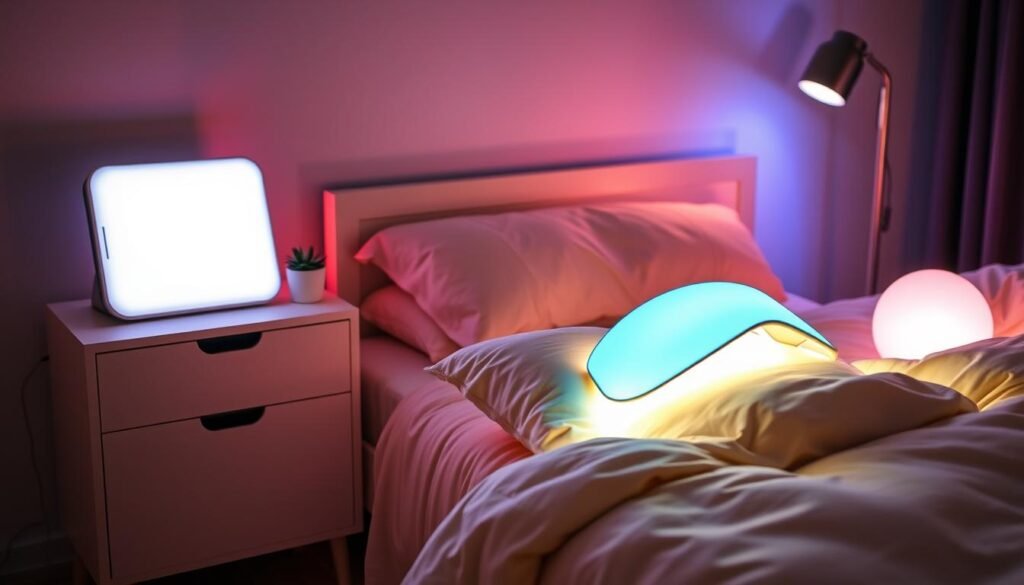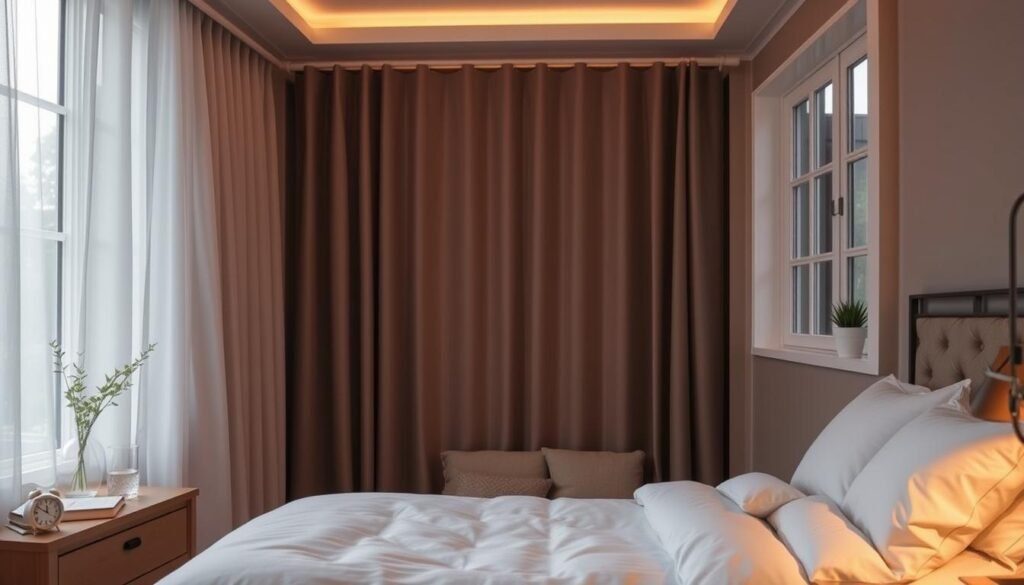Did you know light therapy reduces the chance of a depressive episode by 36% for those with seasonal affective disorder (SAD)? It’s a powerful, natural way to feel better. It also works well for sleep issues like insomnia. Light therapy copies natural sunlight. This helps set our body clocks and makes our sleep better. With more people wanting natural options, light therapy’s popularity for better sleep is growing.
Key Takeaways
- Light therapy can help reset circadian rhythms, aiding in improved sleep.
- Typical sessions range from 20 to 40 minutes, depending on light intensity.
- Users of light therapy may notice improvements within a few days.
- Safety precautions are necessary to prevent eye strain or damage.
- It’s not universally effective, but adjustments can enhance results.
What Is Light Therapy?
Light therapy, also known as bright light therapy or phototherapy, uses special devices called light therapy boxes. These boxes shine light that mimics natural sunlight. This is key in treating issues like insomnia and seasonal affective disorder (SAD). The goal is to adjust the body’s internal clock and improve health.
Patients sit in front of a light therapy box for about 30 to 40 minutes. The light’s intensity is usually between 2,000 to 10,000 lux, based on the condition and doctor’s recommendation. This therapy can reset your circadian rhythms. It makes nighttime sleep better and you more alert during the day.
Light therapy is great for fixing circadian rhythm sleep disorders. These include delayed sleep phase disorder and advanced sleep-wake phase disorder. It’s also good for overcoming jet lag. When circadian rhythms are off, it can lead to ongoing insomnia. Light therapy helps get things back on track.
In Europe, the guidelines for insomnia treatment view light therapy in a positive, though cautious, light. This stems from the growing but still limited research. Light therapy is a noninvasive way to deal with sleep issues and may also help with depression linked to SAD. As research continues, we’re learning more about the benefits of light therapy. It’s becoming key in modern wellness practices.
Understanding the Science Behind Light Therapy
Light therapy is key in treating sleep disorders because it affects our circadian rhythms. These rhythms help us know when to sleep or stay awake, keeping us healthy. Our body’s clock in the hypothalamus responds to light, changing melatonin production. Light tells our body when to make or not make this sleep-helping hormone.
Studies show that not getting enough light can mess up our sleep/wake cycles. This can lead to sleep problems and other health issues. A review of 53 studies found that light therapy can help fix circadian rhythm issues. It may reduce insomnia and improve sleep quality.
Research on light therapy and sleep disorders has been extensive, especially in older adults. The right light intensity, how long it’s used, and when it’s used are crucial. Treatments with light levels from 200 to 10,000 lux for 30 minutes to 8 hours have had success in fixing biological rhythms.
Light therapy isn’t only for sleep issues; it also helps with depression. It shows promise in treating non-seasonal depression in older people. The kind of light needed for therapy is different from normal lighting. It should be customized for the best effect on our biological rhythms.
How Light Therapy Works to Combat Insomnia
Light therapy helps fight insomnia by affecting our sleep-wake cycle. Getting bright light in the morning is key to this. It stops the production of melatonin, the sleep hormone. This makes us more alert during the day, helping us sleep better at night.
To get the best from light therapy, you must be consistent. Studies show that using light therapy for 30 minutes to an hour daily improves sleep, focus, and brain function. Morning sessions are best. The devices used can shine very brightly, between 1,000 and 10,000 lux. This helps reset our internal clock, making sleep easier.
Dawn simulation devices also offer benefits. They slowly brighten over 30 minutes, like a sunrise, with a gentle 300 lux light. This eases our body’s clock into the day more naturally.
Light therapy doesn’t just reduce melatonin. It also increases serotonin, which boosts our mood. This is great for those with mood or sleep problems. A right light schedule can help with insomnia and other sleep disorders.
Keeping the right light exposure all day is crucial for a healthy sleep rhythm. For insomniacs, light therapy could better sleep and life quality. Consult your doctor for advice that fits you. For more on sleep habits, visit this resource.
Benefits of Light Therapy for Insomnia
Light therapy improves sleep for those with insomnia. It helps you fall asleep faster and sleep longer. Benefits of light therapy include adjusting your body’s clock for better rest. This is great for those who struggle to fall or stay asleep.

Bright light therapy, especially above 1,000 lux, can change your sleep cycle quickly. It’s a hope for many seeking insomnia relief. After two weeks, up to 85% see better sleep, studies say.
Light therapy also helps mood disorders, like seasonal affective disorder. It balances sleep hormones and boosts happiness hormones. So, it improves sleep and mood.
This therapy is safe and non-invasive. Few people report negative effects. It’s a natural choice over drugs. Light therapy enhances sleep and mood. Curious about starting light therapy? Expert advice is here. Find tips for chronic insomnia here.
Light Therapy for Insomnia: A Natural Sleep Solution
Many people, over 60 million in the U.S., struggle with sleep. Light therapy offers a hopeful solution for those suffering from insomnia. It improves sleep by aligning our internal clock with the natural light cycle.
How it Regulates Circadian Rhythms
Our bodies follow a natural cycle for sleep and wakefulness, known as circadian rhythms. Exposing ourselves to light in the morning can reset this clock. This helps us stay alert during the day. Using light therapy in the early hours tells our body when it’s time to be awake or sleep, aiding those with sleep issues naturally.
The Role of Melatonin Regulation and Bright Light Exposure
Melatonin is a hormone that makes us feel sleepy, affecting our sleep quality. Light exposure at night can lower melatonin levels. But, the right light therapy can increase its production at the correct times. A regular light therapy routine can help regulate melatonin effectively, offering help for insomnia sufferers.
| Aspect | Impact of Light Therapy |
|---|---|
| Circadian Rhythm Regulation | Aligns internal body clock with natural light patterns |
| Melatonin Production | Increases levels through optimized light exposure |
| Sleep Quality | Improves overall efficiency and reduces disturbances |
| Natural Sleep Solution | Provides a non-pharmaceutical approach to managing insomnia |
Types of Light Therapy Devices
Many people use light therapy to get relief from insomnia and similar issues. Light boxes are the most common type. They are made for use inside and shine as bright as natural sunlight with 10,000 lux. This light helps fix the body’s sleep-wake cycle.
There are also wearable light visors, desk lamps, and alarm clocks with light therapy. Each type varies in light strength, kind, and time of use. Knowing these differences helps people find what works best for them.
| Device Name | Dimensions (inches) | Weight (pounds) | Key Features |
|---|---|---|---|
| Verilux HappyLight Light Therapy Lamp | 4 x 6.25 x 12.5 | 2 | Compact, adjustable brightness |
| Northern Light Technologies Boxelite | 2.5 x 12.25 x 17 | 8 | Large screen, optimal for SAD treatment |
| Lumie Mini | 8.86 x 6.46 x 3.7 | 1.41 | Travel-friendly size |
| Carex’s Sunlite Bright Light Therapy Lamp | 2 x 8.8 x 13.38 | 3.25 | Designed for quick sessions |
| Philips SmartSleep Wake-Up Light | 6 x 10 x 10 | 2.45 | Alarm feature, natural light simulation |
| Erligpowht’s Light Therapy Lamp | 0.59 x 5.11 x 6.69 | 0.675 | Ultra-portable, battery-operated |
| Verilux HappyLight Duo | 10 x 10 x 45.3-61 (adjustable) | 9.9 | Height adjustable, dual-light design |
Experts like those at the Center for Environmental Therapeutics (CET) give advice on light therapy. They say to use light boxes that are big enough, at least 200 square inches. These should also block UV rays to protect your eyes. Plus, using them right after waking up can really help boost your day and health.

Implementing Light Therapy at Home
Using light therapy at home can help with insomnia. It’s easy to add to your daily activities. You can use it while reading or working in front of a special light box. Sticking to a regular schedule makes it work better.
It’s important to follow the guidelines for how long and how bright your sessions should be. Sessions should last 20 to 30 minutes, usually in the morning. During these sessions, try to stay close to the light while doing your everyday tasks.
There are many good things about using light therapy at home. You can choose when and where to do it, making it fit your life. The cost of light therapy devices can vary, but they are generally affordable. Even though insurance might not cover them, there are good options available, like the 10,000-lux light box. Buying a good quality light box can really help you sleep better.
| Device Type | Recommended Lux Level | Usage Time |
|---|---|---|
| Light Box | 10,000 lux | 20-30 minutes |
| Light Visor | 3,000-10,000 lux | Variable, based on preference |
| Dawn Simulator | Soft light | 30 minutes before wake time |
| Desk Lamp | 2,500-10,000 lux | 20-30 minutes |
Building good habits with light therapy can help you sleep better. Making it part of your life can fight insomnia. This can really improve your overall health and happiness.
Is Light Therapy Suitable for Everyone?
Light therapy can help improve sleep and treat various disorders. But it’s not right for everyone. Those interested should think about their health issues and any reasons they shouldn’t use it.
Potential Side Effects and Contraindications
Light therapy has many benefits, but there can be side effects. Headaches, eye strain, and blurry vision are common. People with eye problems like cataracts or those on certain meds may need to be careful. It’s important to know if light therapy is safe for you.
Consulting with a Healthcare Professional
It’s wise to talk to a doctor before trying light therapy. They can look at your health history and suggest the best approach. They’ll help manage any side effects and make sure the therapy fits your needs. If you want to improve your sleep with light therapy, you can learn more here.
Other Use Cases for Light Therapy
Light therapy offers more than just a solution for insomnia. It’s also great for treating seasonal affective disorder (SAD) and various mood issues. Research has found that people with SAD feel better with light therapy. This is especially true in winter when there’s less sunlight. Light therapy helps with symptoms that come with seasonal light changes.
Seasonal Affective Disorder (SAD)
Light therapy can be a game-changer for those suffering from SAD. Using bright light, about 10,000 lux, can boost serotonin and improve mood. Studies show that regular light therapy in winter reduces depression risks by 36%. Even just an hour of light therapy can dramatically lessen depression for SAD patients.
Depression and Mood Disorders
Light therapy is a boon for those with non-seasonal mood disorders too. It offers an effective option beyond standard treatments. Thanks to new techniques, people can enhance mood stability and manage their mental health. This kind approach focuses on fixing sleep cycles and ensuring good sleep. Both are vital for handling mood problems well. For more on light therapy and circadian rhythms, check out this informative article.
Complementary Strategies for Improved Sleep
To get the most out of light therapy, try adding other helpful habits. These habits can make your sleep even better. For example, work on sleep hygiene and use blue light therapy every day.
Sleep Hygiene Practices
Good sleep hygiene helps build healthy sleep habits. Consider these steps to make your sleeping space perfect for rest:
- Go to bed and wake up at the same times every day.
- Create a calming routine before bed to relax and prepare for sleep.
- Avoid screens and bright lights before bed.
- Make sure your sleeping area is comfortable, dark, and cool.
- Stay away from caffeine and big meals before sleep.
Integrating Blue Light Therapy
Adding blue light therapy in the morning helps tune your body clock. It makes you more alert during the day. Look at these benefits:
- Mimics natural sunlight, very helpful in winter.
- Improves your mood and fights the tiredness of insomnia.
- Boosts melatonin in the evening, making it easier to fall asleep.

Using sleep hygiene and blue light therapy together is a great plan for insomnia. Studies show many adults with sleep problems get better with these methods. They feel better overall.
| Strategy | Description |
|---|---|
| Sleep Hygiene | Setting up habits and places that help you sleep well. |
| Blue Light Therapy | Helping your sleep-wake cycle and making you more alert with light. |
| Complementary Strategies | Using different ways together to tackle insomnia and sleep better. |
Conclusion
Light therapy is a hopeful option for those with sleep problems. It uses special light to improve the sleep cycle. This helps people sleep better overall.
More and more studies show that light therapy really helps, especially for cancer survivors. People are sleeping better and feeling less insomnia. It’s an easy method to try for better sleep health.
Research on light therapy keeps growing, showing its promise for better sleep. We still need more studies, but the results so far are positive. It’s becoming a popular, noninvasive choice for improving sleep quality.